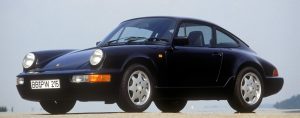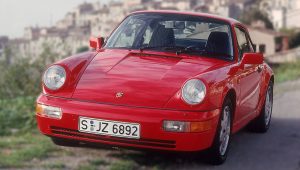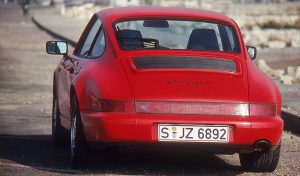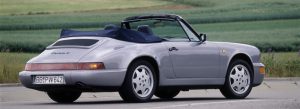
Porsche 911 (type 964) – In the model year 1989, the new generation of the 911 came onto the market at the same time that the G model was discontinued. The type 964 911 Carrera 4 was made up of 85% new parts but largely retained the classic shapes of its predecessor and was available in Coupé, Targa and Cabriolet bodyshell styles. Despite extensive similarities in design, the aerodynamics of the 964 were significantly improved compared with the G model. The new, rounded front and rear sections and an automatically extending rear spoiler contributed to these improved aerodynamics.
The 911 Carrera 4 was the first all-wheel-drive 911. Its electronically controlled permanent all-wheel drive normally directed 31% of the drive torque to the front axle and 69% to the rear axle, though the distribution could be varied depending on the driving situation. There was a traction control switch on the Carrera 4’s centre console. Its 3.6-litre engine delivered 250 PS of power.
From model year 1990, the 911 Carrera 2 – an identical rear-wheel drive version and the first model with Tiptronic – was launched, and from model year 1991 a Turbo variant was also available.
- Models
- 964 Series (1988–1993)
- 964 Turbo (1990–1994)
Porsche 911 : Type 964 (1988-1993)
Classic modernity – Many experts were already prophesying the end of an era, when in 1988 Porsche then unveiled the 911 Carrera 4 (Type 964). After 15 years of production, the 911 was given an 85% upgrade, enabling Porsche to offer a modern, future-proof vehicle. The air-cooled, flat 3.6-litre engine now delivered 250 hp. The main external differences between the 964 and the previous model were the aerodynamic polyurethane bumpers and the electrically powered extendable rear spoiler.
In engineering terms, however, there was hardly anything left to compare. The designers’ aim was that the car should impress not just through its sporty performance, but through its comfortable drive as well. Drivers had the pleasure of ABS, Tiptronic automatic transmission, power steering and airbags.
This 911 also used a totally new kind of chassis with alloy wishbones and coil springs rather than the time-honoured torsion-bar suspension. In practically revolutionary fashion the new 911 was for the first time offered, as the Carrera 4, with all-wheel drive from the outset.
The rear-wheel drive Carrera 2 was not launched until six months later. In addition to the coupé, convertible and Targa models, from 1990 customers were also able to order the 964 Turbo. Initially supplied with the tried and trusted flat 3.3-litre engine, the Turbo was given a 3.6-litre engine delivering 360 hp in 1992. The 911 Carrera RS, 911 Turbo S and 911 Carrera 2 Speedster rate as sought-after collector’s cars.
1989, 911 Carrera 4 Coupé, 3.6 litre
Porsche gained extensive experience of using all-wheel drive in a sports car in the Type 959, a technology demonstrator in every respect. Produced in low numbers as a special series, its influence could be seen in its successor, Porsche’s first series production all-wheel drive sports car, the 911 Carrera 4, which was introduced in 1988.
For excellent driving dynamics, the 959 had an electronic, infinitely variable centre differential lock, and torque was distributed to the two axles depending on the wheel-load distribution and the friction coefficients of the wheels on the road. For the same purpose, the engineers then set up the Carrera 4 with a basic torque distribution of 31 to 69 per cent (front axle to rear axle) via a planetary transfer gear.
The car also featured a hydraulically operated centre and axle differential lock for virtually infinite adjustment of the distribution ratio. Their function was controlled by an electronics system integrated into the ABS control unit. The next Carrera 4, introduced in 1994, represented the next evolutionary stage of the Porsche all-wheel drive. For example, it was fitted with an optimally adapted, very light Visco multi-plate clutch as the axle clutch.
1989: Tiptronic
From 1989, Porsche offered an innovative gearbox in the 964 series 911 – the Tiptronic, the perfect synthesis of comfort and sportiness. The driving data was only marginally lower than that of the same vehicles with manual 5 or 6-speed gearboxes. The Tiptronic was an automatic gearbox with intelligent shift programmes and the opportunity for individual manual intervention.
In addition to the conventional selector lever positions, it also featured a second parallel gate in which simply tapping on the selector lever changed the gear immediately. “Tapping” the lever forwards shifted up a gear and “tapping” it backwards shifted down, as long as the engine speed limits were not exceeded.
If you forgot to shift up, the gearbox automatically shifted to the next gear up when the permitted maximum engine speed was reached. The electronics system had five shift programmes. The programme with the most favourable shifting points was activated, depending on the temperament of the driver and the traffic situation. The engine speed was reduced temporarily by retarding the ignition point in order to facilitate smoother gear changes.

Porsche 911 Turbo (Type 964)
Compared to the Carrera models, the 911 Turbo (Type 964) had a wider bodyshell with wheel housings that were significantly more flared. At the back, the rear wing, largely adopted from the G model Turbo 3.3, and two oval tailpipes emphasised its uniqueness. Exhaust gases only came through the left-hand pipe when the turbocharger’s boost-pressure control valve was open.
In the model years 1991–92, the 911 Turbo was powered by a supercharged 3.3-litre engine that produced 320 PS. In model year 1993 it received a 3.6-litre engine producing 360 PS. This version was recognisable primarily due to its Red brake callipers.
With the exception of a very limited Cabriolet range, the Type-964 911 Turbo was only available as a Coupé.








You must be logged in to post a comment.